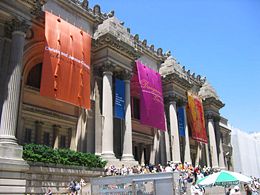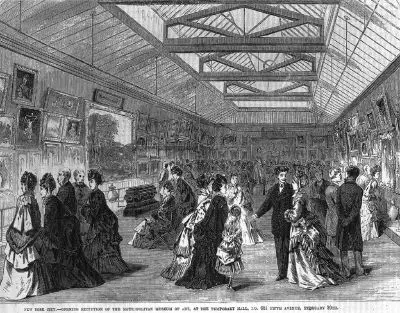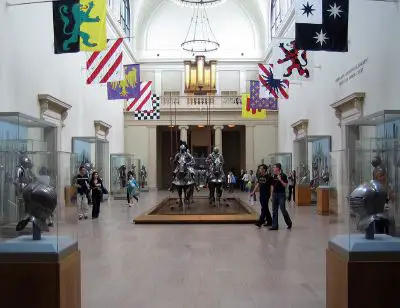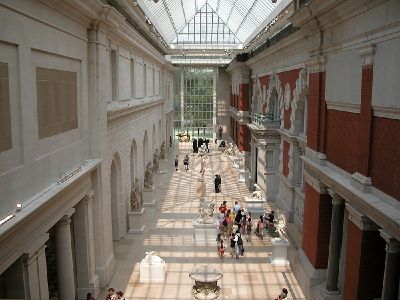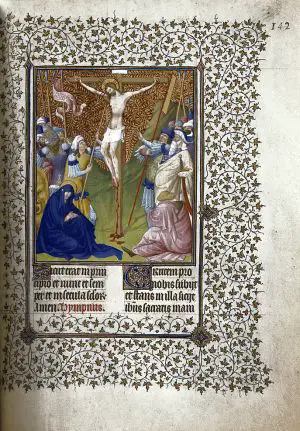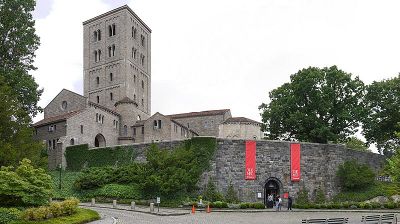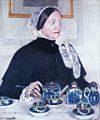Metropolitan Museum of Art
| Established | 1872 |
|---|---|
| Location | Fifth Avenue and 82nd Street, Manhattan, New York |
| Visitor figures | 4 million/year |
| Director | Philippe de Montebello |
| Website | http://www.metmuseum.org/ www.metmuseum.org |
The Metropolitan Museum of Art, founded in 1870 and opened in 1872, is an art museum located on the eastern edge of Central Park, along what is known as Museum Mile in New York City, USA. It has a permanent collection containing more than two million works of art, divided into nineteen curatorial departments. The main building, often referred to simply as "the Met," is one of the world's largest and the finest art galleries. It has a much smaller second location in Upper Manhattan, at "The Cloisters," which features medieval art.
The Museum's collection ranges from ancient to contemporary with origins around the globe. The Museum has been making remarkable efforts in preserving cultural artifacts its high preservation standards. As with the case of other notable museums, the Metropolitan Museum of Art works to enhance people's respect, friendship, and understanding in diverse global community.
Overview
The Met's permanent collection of more than two million works of art is cared for and exhibited by nineteen separate departments, each with a specialized staff of curators, restorers, and scholars.[1]
Represented in the permanent collection are works of art from classical antiquity and Ancient Egypt, paintings and sculptures from nearly all the European masters, and an extensive collection of American and modern art. The Met also maintains extensive holdings of African, Asian, Oceanic, Byzantine and Islamic art.[2] The museum is also home to encyclopedic collections of musical instruments, costumes and accessories, and antique weapons and armor from around the world.[3] A number of notable interiors, ranging from 1st century Rome through modern American design, are permanently installed in the Met's galleries.[4]
In addition to its permanent exhibitions, the Met organizes and hosts numerous special exhibitions and events.[5]
Mission
The Metropolitan Museum of Art has the following mission statement:
The Metropolitan Museum of Art collects, studies, conserves, and presents significant works of art across time and cultures in order to connect all people to creativity, knowledge, ideas, and one another.[6]
Guided by this mission: The Metropolitan Museum of Art presents over 5,000 years of art from around the world for everyone to experience and enjoy. ... Since its founding in 1870, The Met has always aspired to be more than a treasury of rare and beautiful objects. Every day, art comes alive in the Museum's galleries and through its exhibitions and events, revealing new ideas and unexpected connections across time and across cultures.[6]
History
The Metropolitan Museum of Art first opened on February 20, 1872, housed in a building located at 681 Fifth Avenue in New York City. John Taylor Johnston, a railroad executive whose personal art collection seeded the museum, served as its first President, and the publisher George Palmer Putnam came on board as its founding Superintendent. Under their guidance, the Met's holdings, initially consisting of a Roman stone sarcophagus and 174 mostly European paintings, quickly outgrew the available space. In 1873, occasioned by the Met's purchase of the Cesnola Collection of Cypriot antiquities, the museum decamped from Fifth Avenue and took up residence at the Douglas Mansion on West 14th Street. However, these new accommodations were temporary.
After negotiations with the city of New York, the Met acquired land on the east side of Central Park, where it built its permanent home, a red-brick Gothic Revival stone "mausoleum" designed by American architects Calvert Vaux and Jacob Wrey Mould. The Met has remained in this location ever since, and the original structure is still part of its current building. A host of additions over the years, including the distinctive Beaux-Arts facade, designed by Richard Morris Hunt and completed in 1926, have continued to expand the museum's physical structure. As of 2007, the Met measures almost a quarter mile long and occupies more than two million square feet, more than 20 times the size of the original 1880 building.[7]
American decorative arts
The American Decorative Arts Department includes about 12,000 examples of American decorative art, ranging from the late seventeenth to the early twentieth century. Though the Met acquired its first major holdings of American decorative arts via a 1909 donation by Margaret Olivia Slocum Sage, wife of the financier Russell Sage, a decorative arts department specifically dedicated to American works was not established until 1934. One of the prizes of the American Decorative Arts department is its extensive collection of American stained glass. This collection, probably the most comprehensive in the world, includes many pieces by Louis Comfort Tiffany. The department is also well-known for its twenty-five period rooms, each of which recreates an entire room, furnishings and all, from a noted period or designer. The department's current holdings also include an extensive silver collection notable for containing numerous pieces by Paul Revere as well as works by Tiffany & Co.
American paintings and sculpture
Ever since its founding, the Metropolitan Museum of Art has placed a particular emphasis on collecting American art. The first piece to enter the Met's collection was an allegorical sculpture by Hiram Powers titled California, acquired in 1870, which can still be seen in the Met's galleries today. In the following decades, the Met's collection of American paintings and sculpture has grown to include more than one thousand paintings, six hundred sculptures, and 2,600 drawings, covering the entire range of American art from the early Colonial period through the early twentieth century. Many of the best-known American paintings are held in the Met's collection, including a portrait of George Washington by Gilbert Stuart and Emanuel Leutze's monumental Washington Crossing the Delaware. The collection also includes masterpieces by such notable American painters as Winslow Homer, George Caleb Bingham, John Singer Sargent, James McNeill Whistler, and Thomas Eakins.
Ancient Near Eastern art
Beginning in the late 1800s, the Met started to acquire ancient art and artifacts from the Near East. From a few cuneiform tablets and seals, the Met's collection of Near Eastern art has grown to more than 7000 pieces. Representing a history of the region beginning in the Neolithic Period and encompassing the fall of the Sassanian Empire and the end of Late Antiquity, the collection includes works from the Sumerian, Hittite, Sassanian, Assyrian, Babylonian and Elamite cultures (among others), as well as an extensive collection of unique Bronze Age objects. The highlights of the collection include a set of monumental stone lammasu, or guardian figures, from the Northwest Palace of the Assyrian king Ashurnasirpal II.
Arms and armor
The Met's Department of Arms and Armor is one of the museum's most popular collections. The distinctive "parade" of armored figures on horseback installed in the first-floor Arms and Armor gallery is one of the most recognizable images of the museum. The department's focus on "outstanding craftsmanship and decoration," including pieces intended solely for display, means that the collection is strongest in late medieval European pieces and Japanese pieces from the fifth through the nineteenth centuries. However, these are not the only cultures represented in Arms and Armor; in fact, the collection spans more geographic regions than almost any other department, including weapons and armor from dynastic Egypt, ancient Greece, the Roman Empire, the ancient Near East, Africa, Oceania, and the Americas, as well as American firearms (especially Colt firearms) from the nineteenth and twentieth centuries. Among the collection's 15,000 objects are many pieces made for and used by kings and princes, including armor belonging to Henry II of France and Ferdinand I of Germany.
Arts of Africa, Oceania, and the Americas
Though the Met first acquired a group of Peruvian antiquities in 1882, the museum did not begin a concerted effort to collect works from Africa, Oceania, and the Americas until 1969, when American businessman and philanthropist Nelson A. Rockefeller donated his more than 3,000-piece collection to the museum. Today, the Met's collection contains more than 11,000 pieces from sub-Saharan Africa, the Pacific Islands and the Americas and is housed in the 40,000-square-foot (4,000 m²) Rockefeller Wing on the south end of the museum. The collection ranges from 40,000-year-old Australian Aboriginal rock paintings, to a group of fifteen-foot high memorial poles carved by the Asmat people of New Guinea, to a priceless collection of ceremonial and personal objects from the Nigerian Court of Benin. The range of materials represented in the Africa, Oceania, and Americas collection is undoubtedly the widest of any department at the Met, including everything from precious metals to porcupine quills.
Asian art

The Met's Asian department holds a collection of Asian art that is arguably the most comprehensive in the West. The collection dates back almost to the founding of the museum: many of the philanthropists who made the earliest gifts to the museum included Asian art in their collections. Today, an entire wing of the museum is dedicated to the Asian collection, which contains more than 60,000 pieces and spans 4,000 years of Asian art. Every Asian civilization is represented in the Met's Asian department, and the pieces on display include every type of decorative art, from painting and printmaking to sculpture and metalworking. The department is well-known for its comprehensive collection of Chinese calligraphy and painting, as well as for its Nepalese and Tibetan works. However, not only "art" and ritual objects are represented in the collection; many of the best-known pieces are functional objects. The Asian wing even contains a complete Ming Dynasty garden court, modeled on a courtyard in the Garden of the Master of the Fishing Nets in Suzhou.
The Costume Institute
In 1937, the Museum of Costume Art joined with the Met and became its Costume Institute department. Today, its collection contains more than 80,000 costumes and accessories. Due to the fragile nature of the items in the collection, the Costume Institute does not maintain a permanent installation. Instead, every year it holds two separate shows in the Met's galleries using costumes from its collection, with each show centering on a specific designer or theme. In past years, Costume Institute shows organized around famous designers such as Chanel and Gianni Versace have drawn significant crowds to the Met. The Costume Institute's annual Benefit Gala is an extremely popular, if exclusive, event in the fashion world.
Drawings and prints

Though other departments contain significant numbers of drawings and prints, the Drawings and Prints department specifically concentrates on North American pieces and western European works produced after the Middle Ages. Currently, the Drawings and Prints collection contains more than 11,000 drawings, 1.5 million prints, and twelve thousand illustrated books. The collection has been steadily growing ever since the first bequest of 670 drawings donated to the museum by Cornelius Vanderbilt in 1880. The great masters of European painting, who produced many more sketches and drawings than actual paintings, are extensively represented in the Drawing and Prints collection. The department's holdings contain major drawings by Michelangelo, Leonardo da Vinci, and Rembrandt, as well as prints and etchings by Van Dyck, Dürer, and Degas among many others.
Egyptian art
Though the majority of the Met's initial holdings of Egyptian art came from private collections, items uncovered during the museum's own archeological excavations, carried out between 1906 and 1941, constitute almost half of the current collection. More than 36,000 separate pieces of Egyptian art from the Paleolithic era through the Roman era constitute the Met's Egyptian collection, and almost all of them are on display in the museum's massive wing of 40 Egyptian galleries. Among the most valuable pieces in the Met's Egyptian collection are a set of 24 wooden models, discovered in a tomb in Deir el-Bahri in 1920. These models depict, in unparalleled detail, a veritable cross-section of Egyptian life in the early Middle Kingdom : boats, gardens, and scenes of daily life. However, the popular centerpiece of the Egyptian Art department continues to be the Temple of Dendur. Dismantled by the Egyptian government to save it from rising waters caused by the building of the Aswan High Dam, the large sandstone temple was given to the United States in 1965 and assembled in the Met's Sackler Wing in 1978. Situated in a large room, partially surrounded by a reflecting pool and illuminated by a wall of windows opening onto Central Park, the Temple of Dendur is one of the Met's most enduring attractions.
European paintings

The Met has one of the world's best collections of European paintings. Though the collection numbers only around 2,200 pieces, it contains many of the world's most instantly recognizable paintings. The bulk of the Met's purchasing has always been in this department, primarily focusing on Old Masters and nineteenth-century European paintings, with an emphasis on French, Italian and Dutch artists. Many great artists are represented in remarkable depth in the Met's holdings: the museum owns 37 paintings by Monet, 21 oils by Cezanne, and 18 Rembrandts including Aristotle With a Bust of Homer. The Met's five paintings by Vermeer represent the largest collection of the artist's work anywhere in the world. Other highlights of the collection include Van Gogh's Self-Portrait with a Straw Hat, Pieter Bruegel the Elder's The Harvesters, Georges de La Tour's The Fortune Teller, and Jacques-Louis David's The Death of Socrates. In recent decades, the Met has carried out a policy of deaccessioning its "minor" holdings in order to purchase a smaller number of "world-class" pieces. Though this policy remains controversial, it has gained a number of outstanding (and outstandingly expensive) masterpieces for the European Paintings collection, beginning with Velázquez's Juan de Pareja in 1971. One of The Met's latest purchases is Duccio's Madonna and Child, which cost the museum more than 45 million dollars, more than twice the amount it had paid for any previous painting. The painting itself is only slightly larger than 9 by 6 inches, but has been called "the Met's Mona Lisa."
European sculpture and decorative arts
Though European painting may have its own department, other European decorative arts are well-represented at the Met. In fact, the European Sculpture and Decorative Arts collection is one of the largest departments at the Met, holding in excess of 50,000 separate pieces from the 1400s through the early twentieth century. Though the collection is particularly concentrated in Renaissance sculpture—much of which can be seen in situ surrounded by contemporary furnishings and decoration—it also contains comprehensive holdings of furniture, jewelry, glass and ceramic pieces, tapestries, textiles, and timepieces and mathematical instruments. Visitors can enter dozens of completely furnished period rooms, transplanted in their entirety into the Met's galleries. The collection even includes an entire sixteenth-century patio from the Spanish castle of Vélez Blanco, meticulously reconstructed in a two-story gallery. Sculptural highlights of the sprawling department include Bernini's Bacchanal, a cast of Rodin's The Burghers of Calais, and several unique pieces by Houdon, including his Bust of Voltaire and his famous portrait of his daughter Sabine.
Greek and Roman art
The Met's collection of Greek and Roman art contains more than 30,000[8] works dated from the Neolithic period (ca. 4500 B.C.E.) to the time of the Roman emperor Constantine's conversion to Christianity in 312 C.E. The Greek and Roman collection dates back to the founding of the museum—in fact, the museum's first accessioned object was a Roman sarcophagus, still currently on display. Though the collection naturally concentrates on items from ancient Greece and the Roman Empire, these historical regions represent a wide range of cultures and artistic styles, from classic Greek black-figure and red-figure vases to carved Roman tunic pins. Several highlights of the collection include the Euphronios krater depicting the death of Sarpedon (whose ownership has since been transferred to the Republic of Italy), the monumental Amathus sarcophagus, and a magnificently detailed Etruscan chariot known as the "Monteleone chariot." The collection also contains many pieces from far earlier than the Greek or Roman empires—among the most remarkable are a collection of early Cycladic sculptures from the mid-third millennium B.C.E., many so abstract as to seem almost modern. The Greek and Roman galleries also contain several large classical wall paintings and reliefs from different periods, including an entire reconstructed bedroom from a noble villa in Boscoreale, excavated after its entombment by the eruption of Vesuvius in 79 C.E. In 2007, the Met's Greek and Roman galleries were expanded to approximately 60,000 square feet (6,000 m²), allowing the majority of the collection to be on permanent display.[9]
Islamic art
The Met's collection of Islamic art is not confined strictly to religious art, though a significant number of the objects in the Islamic collection were originally created for religious use or as decorative elements in mosques. Much of the 12,000 strong collection consists of secular items, including ceramics and textiles, from Islamic cultures ranging from Spain to North Africa to Central Asia. In fact, the Islamic Art department's collection of miniature paintings from Iran and Mughal India are a highlight of the collection. Calligraphy both religious and secular is well-represented in the Islamic Art department, from the official decrees of Suleiman the Magnificent to a number of Qur'an manuscripts reflecting different periods and styles of calligraphy. As with many other departments at the Met, the Islamic Art galleries contain many interior pieces, including the entire reconstructed Nur Al-Din Room from an early eighteenth century house in Damascus.
Robert Lehman Collection
On the passing of banker Robert Lehman in 1969, his Foundation donated close to 3,000 works of art to the museum. Housed in the "Robert Lehman Wing," the museum refers to the collection as "one of the most distinguished privately assembled art collections in the United States."[10] To emphasize the personal nature of the Robert Lehman Collection, the Met housed the collection in a special set of galleries which evoked the interior of Lehman's richly decorated townhouse; this intentional separation of the Collection as a "museum within the museum" met with mixed criticism and approval at the time, though the acquisition of the collection was seen as a coup for the Met.[11] Unlike other departments at the Met, the Robert Lehman collection does not concentrate on a specific style or period of art; rather, it reflects Lehman's personal interests. Lehman the collector concentrated heavily on paintings of the Italian Renaissance, particularly the Senese school. Paintings in the collection include masterpieces by Botticelli and Domenico Veneziano, as well as works by a significant number of Spanish painters, El Greco and Goya among them. Lehman's collection of drawings by the Old Masters, featuring works by Rembrandt and Dürer, is particularly valuable for its breadth and quality.[12] Princeton University Press has documented the massive collection in a multi-volume book series published as The Robert Lehman Collection Catalogues.
Libraries
The main library at the Met is the Thomas J. Watson Library, named after its benefactor. The Watson Library primarily collects books related to the history of art, including exhibition catalogues and auction sale publications, and generally attempts to reflect the emphasis of the museum's permanent collection. Several of the museum's departments have their own specialized libraries relating to their area of expertise. The Watson Library and the individual departments' libraries also hold substantial examples of early or historically important books which are works of art in their own right. Among these are books by Dürer and Athanasius Kircher, as well as editions of the seminal Surrealist magazine "VVV" and a copy of "Le Description de l'Egypte," commissioned in 1803 by Napoleon Bonaparte and considered one of the greatest achievements of French publishing.
Several of the departmental libraries are open to members of the public without prior appointment. The Library and Teacher Resource Center, Ruth and Harold Uris Center for Education, is open to visitors of all ages to study art and art history and to learn about the Museum, its exhibitions and permanent collection. The Robert Goldwater Library in the department of the Arts of Africa, Oceania, and the Americas documents the visual arts of sub-Saharan Africa, the Pacific Islands, and Native and Precolumbian America. It is open to adult researchers, including college and graduate students. Most of the other departmental libraries are for museum staff only or are open to the general public by appointment only.
Medieval art
The Met's collection of medieval art consists of a comprehensive range of Western art from the fourth century through the early sixteenth century, as well as Byzantine and pre-medieval European antiquities not included in the Ancient Greek and Roman collection. Like the Islamic collection, the Medieval collection contains a broad range of two- and three-dimensional art, with religious objects heavily represented. In total, the Medieval Art department's permanent collection numbers about 11,000 separate objects, divided between the main museum building on Fifth Avenue and The Cloisters.
Main building
The medieval collection in the main Metropolitan building, centered on the first-floor medieval gallery, contains about six thousand separate objects. While a great deal of European medieval art is on display in these galleries, most of the European pieces are concentrated at the Cloisters (see below). However, this allows the main galleries to display much of the Met's Byzantine art side-by-side with European pieces. The main gallery is host to a wide range of tapestries and church and funerary statuary, while side galleries display smaller works of precious metals and ivory, including reliquary pieces and secular items. The main gallery, with its high arched ceiling, also serves double duty as the annual site of the Met's elaborately decorated Christmas tree.
The Cloisters
The Cloisters was a principal project of John D. Rockefeller, Jr., who was a major benefactor of the Met. Located in Fort Tryon Park and completed in 1938, it is a separate building dedicated solely to medieval art. The Cloisters collection was originally that of a separate museum, assembled by George Grey Barnard and acquired in toto by Rockefeller in 1925 as a gift to the Met.[13]
The Cloisters are so named on account of the five medieval French cloisters whose salvaged structures were incorporated into the modern building, and the five thousand objects at the Cloisters are strictly limited to medieval European works. The collection exhibited here features many items of outstanding beauty and historical importance; among these are the Belles Heures du Duc de Berry illustrated by the Limbourg Brothers in 1409, the Romanesque altar cross known as the "Cloisters Cross" or "Bury Cross," and the seven heroically detailed tapestries depicting the Hunt of the Unicorn.
Modern art
With more than 10,000 artworks, primarily by European and American artists, the modern art collection occupies 60,000 square feet (6,000 m²), of gallery space and contains many iconic modern works. Cornerstones of the collection include Picasso's portrait of Gertrude Stein, Jasper Johns's White Flag, Jackson Pollock's Autumn Rhythm (Number 30), and Max Beckmann's triptych Beginning. Certain artists are represented in remarkable depth, for a museum whose focus is not exclusively on modern art: for example, the collection contains forty paintings by Paul Klee, spanning his entire career. Due to the Met's long history, "contemporary" paintings acquired in years past have often migrated to other collections at the museum, particularly to the American and European Paintings departments.
Musical instruments
The Met's collection of musical instruments, with about five thousand examples of musical instruments from all over the world, is virtually unique among major museums. The collection began in 1889 with a donation of several hundred instruments by Lucy W. Drexel, but the department's current focus came through donations over the following years by Mary Elizabeth Adams, wife of John Crosby Brown. Instruments were (and continue to be) included in the collection not only on aesthetic grounds, but also insofar as they embodied technical and social aspects of their cultures of origin. The modern Musical Instruments collection is encyclopedic in scope; every continent is represented at virtually every stage of its musical life. Highlights of the department's collection include several Stradivari violins, a collection of Asian instruments made from precious metals, and the oldest surviving piano, a 1720 model by Bartolomeo Cristofori. Many of the instruments in the collection are playable, and the department encourages their use by holding concerts and demonstrations by guest musicians.
Photographs
The Met's collection of photographs, numbering more than 20,000 in total, is centered on five major collections plus additional acquisitions by the museum. Alfred Stieglitz, a famous photographer himself, donated the first major collection of photographs to the museum, which included a comprehensive survey of Photo-Secessionist works, a rich set of master prints by Edward Steichen, and an outstanding collection of Stieglitz's photographs from his own studio. The Met supplemented Stieglitz's gift with the 8,500-piece Gilman Paper Company Collection, the Rubel Collection, and the Ford Motor Company Collection, which respectively provided the collection with early French and American photography, early British photography, and post-WWI American and European photography. The museum also acquired Walker Evans's personal collection of photographs, a particular coup considering the high demand for his works. Though the department gained a permanent gallery in 1997, not all of the department's holdings are on display at any given time, due to the sensitive materials represented in the photography collection. However, the Photographs department has produced some of the best-received temporary exhibits in the Met's recent past, including a Diane Arbus retrospective and an extensive show devoted to spirit photography.
Special exhibitions
Frank Stella on the Roof features in stainless steel and carbon fiber several works by American artist Frank Stella. This exhibition is set in The Iris and B. Gerald Cantor Roof Garden, offering views of Central Park and the Manhattan skyline.
Coaxing the Spirits to Dance: Art of the Papuan Gulf presents some 60 sculptures and 30 historical photographs from the Gulf province of Papua New Guinea.
Acquisitions and deaccessioning
During the 1970s, under the directorship of Thomas Hoving, the Met revised its deaccessioning policy. Under the new policy, the Met set its sights on acquiring "world-class" pieces, regularly funding the purchases by selling mid- to high-value items from its collection.[11] Though the Met had always sold duplicate or minor items from its collection to fund the acquisition of new pieces, the Met's new policy was significantly more aggressive and wide-ranging than before, and allowed the deaccessioning of items with higher values which would normally have precluded their sale. The new policy provoked a great deal of criticism (in particular, from The New York Times) but had its intended effect.
Many of the items then purchased with funds generated by the more liberal deaccessioning policy are now considered the "stars" of the Met's collection, including Velázquez's Juan de Pareja and the Euphronios krater depicting the death of Sarpedon. The Met has continued the policy in recent years, selling such valuable pieces as Edward Steichen's 1904 photograph The Pond-Moonlight (of which another copy was already in the Met's collection) for a record price of $2.9 million.[14]
In popular culture
- The Met was famously used as the setting for much of the Newbery Medal-winning children's book, From the Mixed-Up Files of Mrs. Basil E. Frankweiler, in which the two young protagonists run away from home and secretly stay several nights in the museum. However, Michelangelo's Angel statue, central to the book's plot, is purely fictional and not actually part of the museum's collection.
- The 1948 film Portrait of Jennie was filmed at the both the Museum and The Cloisters.
- Blair Waldorf, Serena van der Woodsen, and a few select classmates at the Constance Billard School for Girls from Gossip Girl TV series usually eat their lunch on the steps of the Met.
- The Met was featured as the first level in the tactical first-person shooter Tom Clancy's Rainbow Six: Rogue Spear
- The 1999 version of The Thomas Crown Affair uses the Met as a major setting; however, only the exterior scenes were shot at the museum, with the interior scenes filmed on soundstages.
- In 1983, there was a Sesame Street special entitled Don't Eat the Pictures: Sesame Street at the Metropolitan Museum of Art, where the cast goes to visit the museum on-location.
- An episode of Inspector Gadget entitled "Art Heist" had Gadget and Penny and Brain travel to the Met, with Gadget being assigned to protect the artwork. But M.A.D. Agents steal the masterpieces and plan to replace them with fakes.
- In the 2007 movie I Am Legend, the main character is shown fishing in the ruined Egyptian Wing.
- The Met is featured in a season four episode of Project Runway, where five remaining designers must create an outfit based on a work of art.
Gallery of paintings
Notes
- ↑ Collection Areas The Metropolitan Museum of Art. Retrieved May 9, 2023.
- ↑ Barbara Burn, Masterpieces of the Metropolitan Museum of Art (New York: Metropolitan Museum of Art, 1997, ISBN 0300106157).
- ↑ Stuart W. Pyhrr, Arms and Armor: Notable Acquisitions 1991-2002 - The Metropolitan Museum of Art. (New Haven: Yale University Press, 2003, ISBN 0300098766), 6.
- ↑ Amelia Peck, Period Rooms in the Metropolitan Museum of Art (New York: Metropolitan Museum of Art, 1996, ISBN 0300105223), 17, 275.
- ↑ Exhibitions, The Metropolitan Museum of Art. Retrieved May 9, 2023.
- ↑ 6.0 6.1 Mission Statement, The Metropolitan Museum of Art. Retrieved May 9, 2023.
- ↑ The Metropolitan Museum of Art Humanities Web. Retrieved May 9, 2023.
- ↑ Greek and Roman Art . The Metropolitan Museum of Art. Retrieved May 9, 2023.
- ↑ Michael Kimmelman, Classical Treasures, Bathed in a New Light The New York Times, April 20, 2007. Retrieved May 9, 2023.
- ↑ The Robert Lehman Collection The Metropolitan Museum of Art. Retrieved May 9, 2023.
- ↑ 11.0 11.1 Thomas Hoving, Making the Mummies Dance (New York: Touchstone, 1994, ISBN 978-0671880750).
- ↑ John Russell, Art Review: Feast of Illuminations and Drawings, The New York Times, February 18, 2000. Retrieved May 9, 2023.
- ↑ History of the Museum: The Met Cloisters The Metropolitan Museum of Art. Retrieved May 9, 2023.
- ↑ Rare photo sets $2.9m sales record BBC News, February 16, 2006. Retrieved May 9, 2023.
ReferencesISBN links support NWE through referral fees
- Burn, Barbara. Masterpieces of the Metropolitan Museum of Art. New York: Metropolitan Museum of Art, 1997. ISBN 0300106157
- Hoving, Thomas. Making the Mummies Dance. New York: Touchstone, 1994. ISBN 978-0671880750
- Peck, Amelia. Period Rooms in the Metropolitan Museum of Art. New York: Metropolitan Museum of Art, 1996. ISBN 0300105223
- Pyhrr, Stuart W. Arms and Armor: Notable Acquisitions 1991-2002 - The Metropolitan Museum of Art. New Haven: Yale University Press, 2003. ISBN 0300098766
External links
All links retrieved April 29, 2025.
- Metropolitan Museum of Art: official site
- Heilbrunn Timeline of Art History
- The New York Times Metropolitan Museum of Art Topic Page
| |||||
Credits
New World Encyclopedia writers and editors rewrote and completed the Wikipedia article in accordance with New World Encyclopedia standards. This article abides by terms of the Creative Commons CC-by-sa 3.0 License (CC-by-sa), which may be used and disseminated with proper attribution. Credit is due under the terms of this license that can reference both the New World Encyclopedia contributors and the selfless volunteer contributors of the Wikimedia Foundation. To cite this article click here for a list of acceptable citing formats.The history of earlier contributions by wikipedians is accessible to researchers here:
The history of this article since it was imported to New World Encyclopedia:
Note: Some restrictions may apply to use of individual images which are separately licensed.
